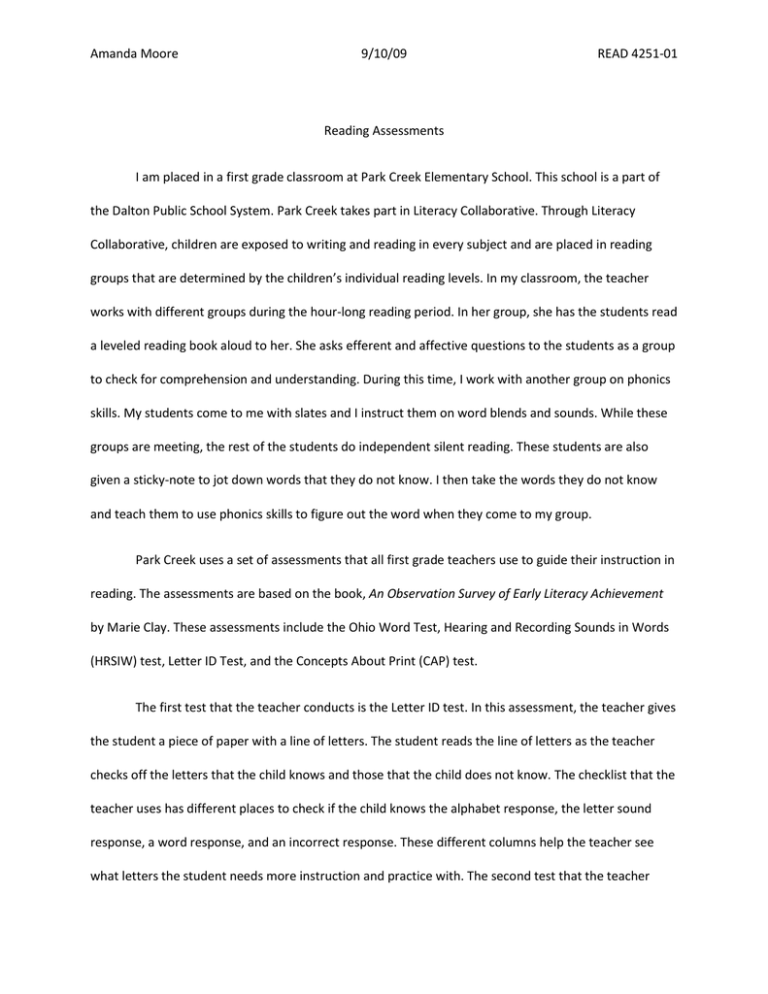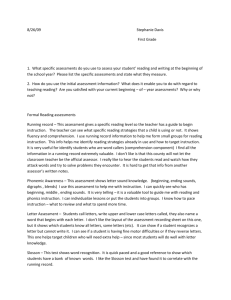Reading_Assessments_Paper
advertisement

Amanda Moore 9/10/09 READ 4251-01 Reading Assessments I am placed in a first grade classroom at Park Creek Elementary School. This school is a part of the Dalton Public School System. Park Creek takes part in Literacy Collaborative. Through Literacy Collaborative, children are exposed to writing and reading in every subject and are placed in reading groups that are determined by the children’s individual reading levels. In my classroom, the teacher works with different groups during the hour-long reading period. In her group, she has the students read a leveled reading book aloud to her. She asks efferent and affective questions to the students as a group to check for comprehension and understanding. During this time, I work with another group on phonics skills. My students come to me with slates and I instruct them on word blends and sounds. While these groups are meeting, the rest of the students do independent silent reading. These students are also given a sticky-note to jot down words that they do not know. I then take the words they do not know and teach them to use phonics skills to figure out the word when they come to my group. Park Creek uses a set of assessments that all first grade teachers use to guide their instruction in reading. The assessments are based on the book, An Observation Survey of Early Literacy Achievement by Marie Clay. These assessments include the Ohio Word Test, Hearing and Recording Sounds in Words (HRSIW) test, Letter ID Test, and the Concepts About Print (CAP) test. The first test that the teacher conducts is the Letter ID test. In this assessment, the teacher gives the student a piece of paper with a line of letters. The student reads the line of letters as the teacher checks off the letters that the child knows and those that the child does not know. The checklist that the teacher uses has different places to check if the child knows the alphabet response, the letter sound response, a word response, and an incorrect response. These different columns help the teacher see what letters the student needs more instruction and practice with. The second test that the teacher Amanda Moore 9/10/09 READ 4251-01 conducts is the Ohio Word Test. This test consists of different lists of words (List A, List B, and List C). The teacher starts the student on List B (1st grade level), and then has the child read the words down the list. The teacher documents any words that are missed by recording the incorrect response next to the word on her checklist. The third assessment the teacher uses in reading is the Hearing and Recording Sounds in Words test. The teacher reads a short paragraph to the student two times. On the second time, the child writes down the words they hear in the story. The students’ goal is to ultimately write the paragraph as they hear the words the teacher says. The last assessment that the teacher uses is the Concepts About Print test. This test involves the student using a book to show that they know which way to read, what the front of the book is, where to start reading, etc. The teacher then uses a checklist to assess what the student knows and doesn’t know about books and the print within that book. All of these tests are given four times a year to monitor student progress. My site teacher uses the results of these assessments to determine what concepts about reading need the most attention. She then constructs her reading lesson plans according to the results. For example, if the teacher sees that many students are missing words beginning with a /ch/ blend, she will teach a whole lesson on this blend in order for students to become more familiar with this concept. She also uses the assessments to place students in reading groups. Through seeing what words the students can read and what list those students are on, she is able to place her students in leveled groups. I would use these assessments to keep a log of what my students’ strengths and weaknesses in reading are. I would then use this log to determine what I would teach throughout the year. If most of the students’ strengths are in the same area, it would help me know that I would not need to spend much time on that certain concept. If most of the students have the same weakness in a certain area, I could make a lesson plan for that concept and teach the students accordingly. I would also use this Amanda Moore 9/10/09 READ 4251-01 information to determine if some students have developmental disabilities in reading. For example, I could use the letter ID test in order to see if students have problems reading letters backwards (saying d for b or p for q). I could use the Hearing and Recording assessment to determine if children in my classroom may have problems in hearing certain sounds. I could then find ways to remedy these problems for my students and effectively teach reading to each of my students.



